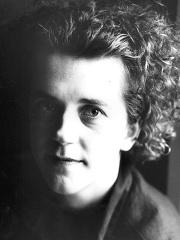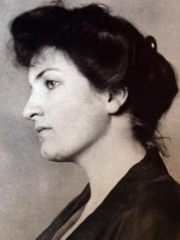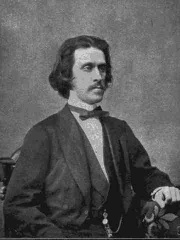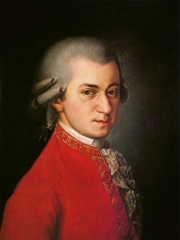
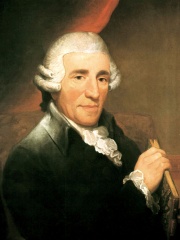
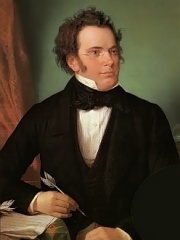
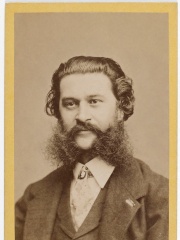
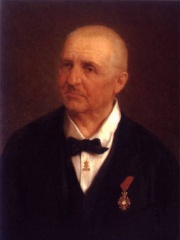
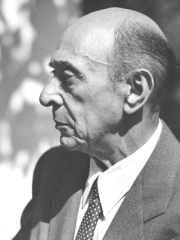
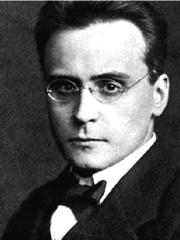

The Most Famous
COMPOSERS from Austria
This page contains a list of the greatest Austrian Composers. The pantheon dataset contains 1,451 Composers, 64 of which were born in Austria. This makes Austria the birth place of the 7th most number of Composers behind United Kingdom, and Russia.
Top 10
The following people are considered by Pantheon to be the top 10 most legendary Austrian Composers of all time. This list of famous Austrian Composers is sorted by HPI (Historical Popularity Index), a metric that aggregates information on a biography's online popularity. Visit the rankings page to view the entire list of Austrian Composers.

1. Wolfgang Amadeus Mozart (1756 - 1791)
With an HPI of 95.37, Wolfgang Amadeus Mozart is the most famous Austrian Composer. His biography has been translated into 222 different languages on wikipedia.
Wolfgang Amadeus Mozart (27 January 1756 – 5 December 1791) was a prolific and influential composer of the Classical period. Despite his short life, his rapid pace of composition and proficiency from an early age resulted in more than 800 works representing virtually every Western classical genre of his time. Many of these compositions are acknowledged as pinnacles of the symphonic, concertante, chamber, opera, and choral repertoires. Mozart is widely regarded as one of the greatest composers in the history of Western music, with his music admired for its "melodic beauty, its formal elegance and its richness of harmony and texture". Born in Salzburg, Mozart showed prodigious ability from his earliest childhood. At age five, he was already competent on keyboard and violin, had begun to compose, and performed before European royalty. His father, Leopold Mozart, took him on a grand tour of Europe and then three trips to Italy. At 17, he was a musician at the Salzburg court but grew restless and travelled in search of a better position. Mozart's fruitless journey in search of employment led him to Paris, Mannheim, Munich, and eventually back to Salzburg. During this time he wrote his five violin concertos, the Sinfonia Concertante, and Concerto for Flute and Harp, as well as sacred pieces and masses, the motet Exsultate Jubilate, and the opera Idomeneo, among other works. While visiting Vienna in 1781, Mozart was dismissed from his Salzburg position. He stayed in Vienna, where he achieved fame but little financial security. During Mozart's early years in Vienna, he produced several notable works, such as the opera Die Entführung aus dem Serail, the Great Mass in C minor, the "Haydn" Quartets and a number of symphonies. Throughout his Vienna years, Mozart composed over a dozen piano concertos, many considered some of his greatest achievements. In the final years of his life, Mozart wrote many of his best-known works, including his last three symphonies, culminating in the Jupiter Symphony, the serenade Eine kleine Nachtmusik, his Clarinet Concerto, the operas The Marriage of Figaro, Don Giovanni, Così fan tutte and The Magic Flute and his Requiem. The Requiem was largely unfinished at the time of his death at age 35, the circumstances of which are uncertain and much mythologised.

2. Joseph Haydn (1732 - 1809)
With an HPI of 88.30, Joseph Haydn is the 2nd most famous Austrian Composer. His biography has been translated into 130 different languages.
Franz Joseph Haydn ( HY-dən; German: [ˈfʁants ˈjoːzɛf ˈhaɪdn̩] ; 31 March 1732 – 31 May 1809) was a composer of the Classical period. He was instrumental in the development of chamber music such as the string quartet and piano trio. His contributions to musical form have led him to be called "Father of the Symphony" and "Father of the String quartet". Haydn arose from humble origins, the child of working people in a rural village. He established his career first by serving as a chorister at St. Stephen's Cathedral, Vienna, then through an arduous period as a freelance musician. Eventually he found career success, spending much of his working life as music director for the wealthy Esterházy family at their palace of Eszterháza in rural Hungary. Though he had his own orchestra there, it isolated him from other composers and trends in music so that he was, as he put it, "forced to become original". During this period his music circulated widely in publication, eventually making him the most celebrated composer in Europe. With the death of his patron Nikolaus Esterházy in 1790, Haydn was free to travel, and augmented his fame—now as a performer before the public—in both London and Vienna. The last years of his life (1803–1809) were spent in a state of debility, unable to compose due to poor health. He died in Vienna in 1809 at the age of 77. Haydn was a friend and mentor of Mozart, a teacher of Beethoven, and the elder brother of composer Michael Haydn.

3. Franz Schubert (1797 - 1828)
With an HPI of 87.80, Franz Schubert is the 3rd most famous Austrian Composer. His biography has been translated into 137 different languages.
Franz Peter Schubert (; German: [fʁants ˈpeːtɐ ˈʃuːbɐt]; 31 January 1797 – 19 November 1828) was an Austrian composer of the late Classical and early Romantic eras. Despite his short life, Schubert left behind a vast oeuvre, including more than 600 Lieder (art songs in German) and other vocal works, seven complete symphonies, sacred music, operas, incidental music, and a large body of piano and chamber music. His major works include the songs "Erlkönig", "Gretchen am Spinnrade", and "Ave Maria"; the Trout Quintet; the Symphony No. 8 in B minor (Unfinished); the Symphony No. 9 in C major (The Great); the String Quartet No. 14 in D minor (Death and the Maiden); the String Quintet in C major; the Impromptus for solo piano; the last three piano sonatas; the Fantasia in F minor for piano four hands; the opera Fierrabras; the incidental music to the play Rosamunde; and the song cycles Die schöne Müllerin, Winterreise, and Schwanengesang. Born in the Himmelpfortgrund suburb of Vienna, Schubert showed uncommon gifts for music from an early age. His father gave him his first violin lessons and his elder brother gave him piano lessons, but Schubert soon exceeded their abilities. In 1808, at the age of eleven, he became a pupil at the Stadtkonvikt school, where he became acquainted with the orchestral music of Joseph Haydn, Wolfgang Amadeus Mozart, and Ludwig van Beethoven. He left the Stadtkonvikt at the end of 1813 and returned home to live with his father, where he began studying to become a schoolteacher. Despite this, he continued his studies in composition with Antonio Salieri and still composed prolifically. In 1821, Schubert was admitted to the Gesellschaft der Musikfreunde as a performing member, which helped establish his name among the Viennese citizenry. He gave a concert of his works to critical acclaim in March 1828, the only time he did so in his career. He died eight months later at the age of 31, the cause officially attributed to typhoid fever, but believed by some historians to be syphilis. Appreciation of Schubert's music while he was alive was limited to a relatively small circle of admirers in Vienna, but interest in his work increased greatly in the decades following his death. Felix Mendelssohn, Robert Schumann, Franz Liszt, Johannes Brahms and other 19th-century composers discovered and championed his works. Today, Schubert is considered one of the greatest composers in the history of Western classical music and his music continues to be widely performed.

4. Johann Strauss II (1825 - 1899)
With an HPI of 84.64, Johann Strauss II is the 4th most famous Austrian Composer. His biography has been translated into 81 different languages.
Johann Baptist Strauss II (; German: [ˈjoːhan bapˈtɪst ˈʃtʁaʊs]; 25 October 1825 – 3 June 1899), also known as Johann Strauss Jr., the Younger or the Son (German: Johann Strauß Sohn), was an Austrian composer of light music, particularly dance music and operettas, as well as a violinist. He composed over 500 waltzes, polkas, quadrilles, and other types of dance music, as well as several operettas and a ballet. In his lifetime, he was known as "The Waltz King", as he played a major role in popularizing the waltz in the 19th century. Some of Johann Strauss's most famous works include "The Blue Danube", "Kaiser-Walzer" (Emperor Waltz), "Tales from the Vienna Woods", "Frühlingsstimmen", and the "Tritsch-Tratsch-Polka". Among his operettas, Die Fledermaus and Der Zigeunerbaron are the best known. Strauss was the son of Johann Strauss I and his first wife Maria Anna Streim. The two younger brothers, Josef and Eduard Strauss, also became composers of light music, although they were never as well known as their brother.
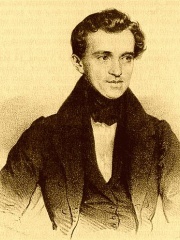
5. Johann Strauss I (1804 - 1849)
With an HPI of 80.34, Johann Strauss I is the 5th most famous Austrian Composer. His biography has been translated into 56 different languages.
Johann Baptist Strauss I (; German: [ˈjoːhan bapˈtɪst ˈʃtʁaʊs]; 14 March 1804 – 25 September 1849), also known as Johann Strauss Sr., the Elder or the Father (German: Johann Strauß Vater), was an Austrian composer of the Romantic Period. He was famous for his light music, namely waltzes, polkas, and galops, which he popularized alongside Joseph Lanner, thereby setting the foundations for his sons—Johann, Josef and Eduard—to carry on his musical dynasty. He is best known for his composition of the Radetzky March (named after Joseph Radetzky von Radetz).

6. Anton Bruckner (1824 - 1896)
With an HPI of 79.85, Anton Bruckner is the 6th most famous Austrian Composer. His biography has been translated into 80 different languages.
Joseph Anton Bruckner (; German: [ˈantoːn ˈbʁʊknɐ] ; 4 September 1824 – 11 October 1896) was an Austrian composer and organist best known for his symphonies and sacred music, which includes Masses, Te Deum and motets. The symphonies are considered emblematic of the final stage of Austro-German Romanticism because of their rich harmonic language, strongly polyphonic character, and considerable length. Bruckner's compositions helped to define contemporary musical radicalism, owing to their dissonances, unprepared modulations, and roving harmonies. Unlike other musical radicals such as Richard Wagner and Hugo Wolf, Bruckner showed respect, even humility, before other famous musicians, Wagner in particular. This apparent dichotomy between Bruckner the man and Bruckner the composer hampers efforts to describe his life in a way that gives a straightforward context for his music. The German conductor Hans von Bülow described him as "half genius, half simpleton". Bruckner was critical of his own work and often reworked his compositions. There are several versions of many of his works. His works, the symphonies in particular, had detractors, most notably the influential Austrian critic Eduard Hanslick and other supporters of the German composer Johannes Brahms, who pointed to their large size and use of repetition, as well as to Bruckner's propensity for revising many of his works, often with the assistance of colleagues, and his apparent indecision about which versions he preferred. On the other hand, Bruckner was greatly admired by subsequent composers, including his friend Gustav Mahler.

7. Arnold Schoenberg (1874 - 1951)
With an HPI of 79.61, Arnold Schoenberg is the 7th most famous Austrian Composer. His biography has been translated into 73 different languages.
Arnold Schoenberg or Schönberg (13 September 1874 – 13 July 1951) was an Austrian and American composer, music theorist, teacher and writer. He was among the first modernists who transformed the practice of harmony in 20th-century classical music, and a central element of his music was its use of motifs as a means of coherence. He propounded concepts like developing variation, the emancipation of the dissonance, and the "unity of musical space". Schoenberg's early works, like Verklärte Nacht (1899), represented a Brahmsian–Wagnerian synthesis on which he built. Mentoring Anton Webern and Alban Berg, he became the central figure of the Second Viennese School. They consorted with visual artists, published in Der Blaue Reiter, and wrote atonal, expressionist music, attracting fame and stirring debate. In his String Quartet No. 2 (1907–1908), Erwartung (1909), and Pierrot lunaire (1912), Schoenberg visited extremes of emotion; in self-portraits he emphasized his intense gaze. While working on Die Jakobsleiter (from 1914) and Moses und Aron (from 1923), Schoenberg confronted popular antisemitism by returning to Judaism and substantially developed his twelve-tone technique. He systematically interrelated all notes of the chromatic scale in his twelve-tone music, often exploiting combinatorial hexachords and sometimes admitting tonal elements. Schoenberg resigned from the Prussian Academy of Arts (1926–1933), emigrating as the Nazis took power; they banned his (and some of his students') music, labeling it "degenerate". He taught in the US, including at the University of California, Los Angeles (1936–1944), where facilities are named in his honor. He explored writing film music (as he had done idiosyncratically in Begleitungsmusik zu einer Lichtspielscene, 1929–1930) and wrote more tonal music, completing his Chamber Symphony No. 2 in 1939. With citizenship (1941) and US entry into World War II, he satirized fascist tyrants in Ode to Napoleon (1942, after Byron), deploying Beethoven's fate motif and the Marseillaise. Post-war Vienna beckoned with honorary citizenship, but Schoenberg was ill as depicted in his String Trio (1946). As the world learned of the Holocaust, he memorialized its victims in A Survivor from Warsaw (1947). The Israel Conservatory and Academy of Music elected him honorary president (1951). His innovative music was among the most influential and polemicized of 20th-century classical music. At least three generations of composers extended its somewhat formal principles. His aesthetic and music-historical views influenced musicologists Theodor W. Adorno and Carl Dahlhaus. The Arnold Schönberg Center collects his archival legacy.

8. Anton Webern (1883 - 1945)
With an HPI of 78.67, Anton Webern is the 8th most famous Austrian Composer. His biography has been translated into 54 different languages.
Anton Webern (German: [ˈantoːn ˈveːbɐn] ; 3 December 1883 – 15 September 1945) was an Austrian composer, conductor, and musicologist. His music was among the most radical of its milieu in its lyrical, poetic concision and use of then novel atonal and twelve-tone techniques. His approach was typically rigorous, inspired by his studies of the Franco-Flemish School under Guido Adler and by Arnold Schoenberg's emphasis on structure in teaching composition from the music of Johann Sebastian Bach, the First Viennese School, and Johannes Brahms. Webern, Schoenberg, and their colleague Alban Berg were at the core of what became known as the Second Viennese School. Webern was arguably the first and certainly the last of the three to write music in an aphoristic and expressionist style, reflecting his instincts and the idiosyncrasy of his compositional process. He treated themes of loss, love, nature, and spirituality, working from personal experiences. Unhappily peripatetic and often assigned light music or operetta in his early conducting career, he aspired to conduct what was seen as more respectable, serious music at home in Vienna. Following Schoenberg's guidance, Webern attempted to write music of greater length during and after their World War I service, relying on the structural support of texts in many Lieder. He rose as a choirmaster and conductor, championing Gustav Mahler's music in Red Vienna and abroad. With Schoenberg based in Berlin, Webern began writing music of increasing confidence, independence, and scale using twelve-tone technique. Marginalized as a "cultural Bolshevist" in Fascist Austria and Nazi Germany, he maintained "the path to the new music", enjoyed international recognition, and relied more on teaching for income. He opposed fascist cultural positions but always espoused pan-Germanism and was torn, like divided friends and family, among uncertainties. His hope for moderate, stable, and successful governance of Austria within Nazi Germany proved misplaced, and he helped Jewish friends emigrate and hide while repeatedly considering emigrating himself. A soldier accidentally killed Webern after World War II. In a phenomenon known as post-Webernism, his music was celebrated by composers, musicians, and scholars. René Leibowitz, Pierre Boulez, Robert Craft, and Hans and Rosaleen Moldenhauer established it as an important part of modernism through performance, study, and advocacy. Igor Stravinsky assimilated it. To many, it represented a path to serialism. Broader understanding of Webern's expressive agenda, performance practice, and complex sociocultural and political context lagged. An historical edition of his music is underway.

9. Alban Berg (1885 - 1935)
With an HPI of 76.26, Alban Berg is the 9th most famous Austrian Composer. His biography has been translated into 55 different languages.
Alban Maria Johannes Berg ( BAIRG; Austrian German: [ˈalbaːn ˈbɛrg]; 9 February 1885 – 24 December 1935) was an Austrian composer of the Second Viennese School. His compositional style combined Romantic lyricism with the twelve-tone technique. Although he left a relatively small oeuvre, he is remembered as one of the most important composers of the 20th century for his expressive style encompassing "entire worlds of emotion and structure". Berg was born and lived in Vienna. He began to compose at the age of fifteen. He studied counterpoint, music theory and harmony with Arnold Schoenberg between 1904 and 1911, and adopted his principles of developing variation and the twelve-tone technique. Berg's major works include the operas Wozzeck (1924) and Lulu (1935, finished posthumously), the chamber pieces Lyric Suite and Chamber Concerto, as well as a Violin Concerto. He also composed a number of songs (lieder). He is said to have brought more "human values" to the twelve-tone system; his works are seen as more "emotional" than those of Schoenberg. His music had a surface glamour that won him admirers when Schoenberg himself had few. Berg died from sepsis in 1935.
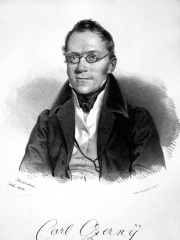
10. Carl Czerny (1791 - 1857)
With an HPI of 75.65, Carl Czerny is the 10th most famous Austrian Composer. His biography has been translated into 48 different languages.
Carl Czerny (; German: [ˈtʃɛʁniː]; 21 February 1791 – 15 July 1857) was an Austrian composer, teacher, and pianist of Czech origin whose music spanned the late Classical and early Romantic eras. His vast musical production amounted to over a thousand works and his books of studies for the piano are still widely used in piano teaching. He was one of Ludwig van Beethoven's best-known pupils and would later on be one of the main teachers of Franz Liszt.
People
Pantheon has 64 people classified as Austrian composers born between 1620 and 1968. Of these 64, 3 (4.69%) of them are still alive today. The most famous living Austrian composers include Georg Friedrich Haas, Harald Kloser, and Olga Neuwirth. The most famous deceased Austrian composers include Wolfgang Amadeus Mozart, Joseph Haydn, and Franz Schubert.
Living Austrian Composers
Go to all RankingsGeorg Friedrich Haas
1953 - Present
HPI: 54.34
Harald Kloser
1956 - Present
HPI: 52.06
Olga Neuwirth
1968 - Present
HPI: 49.94
Deceased Austrian Composers
Go to all RankingsWolfgang Amadeus Mozart
1756 - 1791
HPI: 95.37
Joseph Haydn
1732 - 1809
HPI: 88.30
Franz Schubert
1797 - 1828
HPI: 87.80
Johann Strauss II
1825 - 1899
HPI: 84.64
Johann Strauss I
1804 - 1849
HPI: 80.34
Anton Bruckner
1824 - 1896
HPI: 79.85
Arnold Schoenberg
1874 - 1951
HPI: 79.61
Anton Webern
1883 - 1945
HPI: 78.67
Alban Berg
1885 - 1935
HPI: 76.26
Carl Czerny
1791 - 1857
HPI: 75.65
Alma Mahler
1879 - 1964
HPI: 74.46
Josef Strauss
1827 - 1870
HPI: 73.21
Overlapping Lives
Which Composers were alive at the same time? This visualization shows the lifespans of the 25 most globally memorable Composers since 1700.



